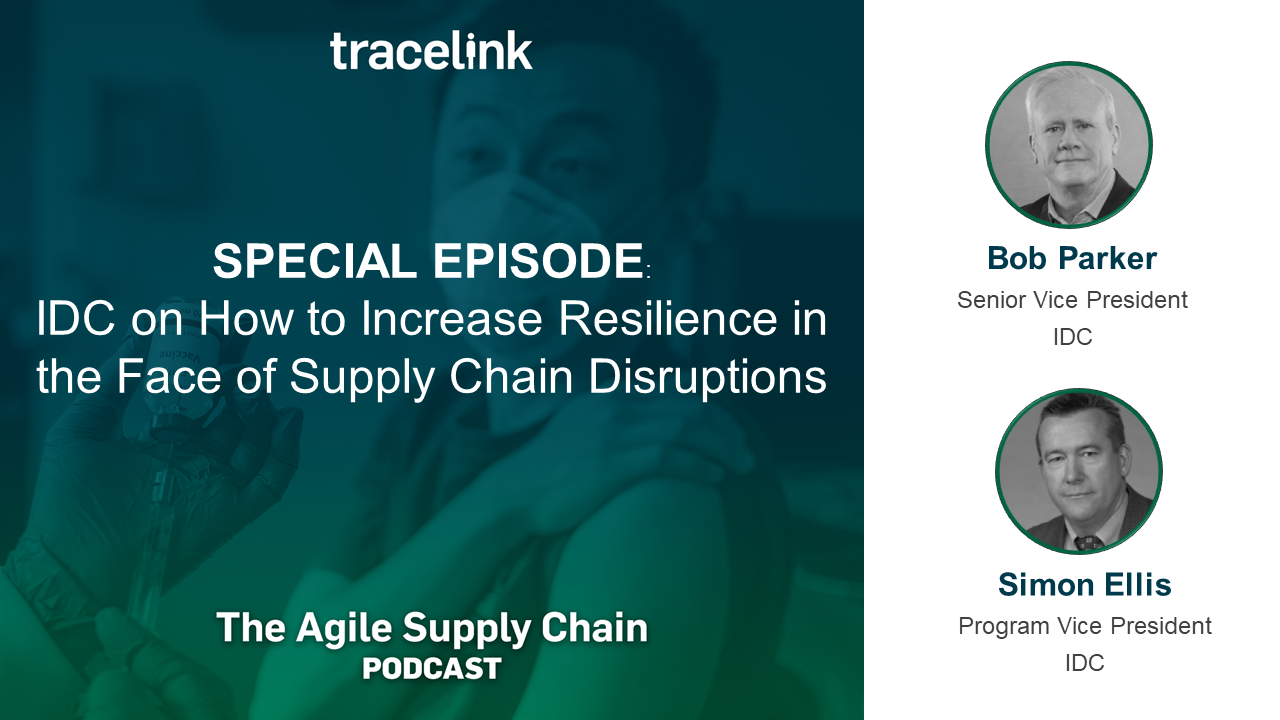Table of contents
Key Takeaways
- Gaining end-to-end supply chain visibility alone is not enough. You also need the ability to rapidly intervene and adapt to new conditions when supply chain disruptions are spotted.
- Pharma supply chain companies should consider creating a decision environment that serves as a “process twin,” enabling them to quickly identify root causes and rectify adverse events in the supply chain.
- Companies should stop deploying local or siloed solutions to fix problems. It’s time to do away with the “metaphorical Band-aids” and start thinking holistically about how to achieve supply chain resiliency.
- The Agile Supply Chain Credo is a set of guiding principles for transforming your supply chain and achieving real patient-centricity.

IDC’s Bob Parker and Simon Ellis share groundbreaking research on how ongoing supply chain disruptions caused by COVID-19 are impacting the pharmaceutical industry. They also offer expert tips on how to adopt a holistic view of the end-to-end supply chain, achieve greater agility, and boost supply chain resiliency.
Transcript: IDC's Bob Parker and Simon Ellis share groundbreaking research on the impact of COVID‑19 and expert tips on how to achieve supply chain resilience. That's right now on "The Agile Supply Chain Podcast."
Good morning, Bob and Simon from IDC. Welcome to this thought leadership series that we're doing at TraceLink where we have the privilege to interview global supply chain thought leaders and analysts consultants on the agile supply chain. The timing for all of this, no timing is perfect in a pandemic sense, but the timing is good given what we learned, etc.
I've asked the two of you after a very successful IDC benchmarking effort that TraceLink commissioned IDC with on disruptions in supply chain, to talk about The Agile Supply Chain Credo that we produced inside and with input from you as well.
Just to emphasize ‑‑ it's technology and vendor agnostic. TraceLink sponsored and was the catalyst, but it's by no means about our products or just about TraceLink. Of course, we subscribe to it.
Without any further do, let me ask each of you to introduce yourselves. The next point is to ask you what pops out at you from the credo? What really gets you? I'm sure the discussion will get heated after that. Bob, over to you.
Bob Parker: Thanks, Roddy. Hello, everyone. I'm Bob Parker. I'm a senior vice president at IDC responsible for our industry research, our enterprise software research, and our professional services research, so those groups.
Roddy, you and I go way back. We're some of the original thinkers around the supply chain operating reference model. Back to that, and how the credo putting this into the public domain is very similar to the efforts we did way back at AMR Research around that model.
What comes out for me is the patient‑centricity. We talk a lot in our health insights practice about value‑based medicine, which is defined as the best possible outcome at the lowest possible cost.
If we can organize the supply chain around that purpose rather than individual self‑interest, we can accomplish that promise of true value‑based medicine and the best possible outcomes for the patient at the lowest possible cost.
Companies need to stop thinking about their supply chain as arm's length transactions, upstream and downstream. They really need to start to think about creating a common purpose that everyone can profit from.
Roddy: Well said. Part of the challenge is think about CMOs and suppliers to manufacturing companies, do they ever get to touch the patient? They probably don't. Patient‑centric is a big vision for the organization. We've got to make it real. Simon, over to you.
Simon Ellis: Good morning, Roddy. Pleasure to be with you here today. Simon Ellis, IDC. I introduce myself these days is all things supply chain even though that isn't strictly true. There are certainly many other folks at IDC who I rely on to do external research.
I've been with IDC for 13 years. I was a consumer of the work that Roddy and Bob did many years ago when I was at a CPG company before IDC. I'm not ashamed to say that I am a supply chain geek. I have been for a long time.
This idea of visibility plus agility equating to resiliency is something that I've talked about for some years now, but it's really come into focus in 2021. We've had so many issues with both the supply and the demand side of the supply chain. Roddy saw it.
The Agile Supply Chain Credo speaks to me because it really does focus in on that idea that I have to be able to see what's happening. Not just see what's happening though, I have to be able to do something about it. I don't want to be a spectator to an unfolding disaster.
I want to be able to intervene. I want to be agile. I want to be able to make the right moves at the right time so that what I've seen doesn't impact me as much as potentially it may my competitors.
If I do those two things, I get resiliency. Roddy, as you well know, we saw a lot of those themes in the benchmarking study that Roddy mentioned, that TraceLink commissioned us to do.
Roddy: We're affectionately going to refer to "Simon's formula" going on because it's profoundly simple. I'm going to come back to that formula and maybe you can expand a little bit on it because it's a great takeaway. Bob, you and I had a discussion around the pivot from business‑centric to patient‑centric.
I'd like you to talk a little to that because whilst it's a very simple face‑value statement, it has profound implications on how you structure your operating model of the business and what's likely to change. Let's start off with that perspective from you.
Bob: It goes pre‑pandemic. As we talked about digital transformation within the life science industry, we at IDC, our life science team talks a lot about knowledge‑based medicine. That aligns with the patient‑centric view of the world because we think that companies that can create economies of intelligence.
If you think about the history of industry, it's gone from economies of scale, to economies of scope, to economies of learning. We're clearly now in economies of intelligence. That really depends on a company's ability to do really three things in our mind.
You need to be able to synthesize data and information. You need to increase your capacity to learn. You need to be able to do that at scale.
On the synthesize information side, what we see companies trying to do incorrectly is they're looking at their traditional enterprise apps as the source of the data that they need to do better knowledge management, better learning. That's a fallacy because if it's your ERP system and even some of your supply chain systems, it's very transactional and it's a performance context.
It's like driving the boat by looking at the wake. What companies really need to start to do is think about the telemetry or the instrumentation of the process to get a situational context of what's going on.
If I'm going to be truly patient‑centric, I need to be able to instrument my processes so that I can have a situational context. I can drive automation where I need it and take the most advantage of my human skills at my company for the higher-level insight.
I would recommend that companies stop completely depending on their traditional enterprise application data which is backward‑looking and performance‑based and start thinking about how they instrument their processes so that they can understand the situational context and make more resilient decisions. That's the operating model.
Roddy: I love that because there's two thoughts that immediately jumped to mind. This idea that you and I have been writing about for 10, 15 years that the digital twin being able to separate the flow of information from the flow of the physical product.
The physical product is so critical in health care, margins of 80 percent plus and 300 days’ worth of inventory, that's all they really care about. The information flowed with a product.
Now being able to get ahead of that flow of the product and start doing augmented analytics and predictive analytics because you've learned so much from the past that you can predict what's likely to happen in the future. That's profound.
The credo really focused a lot on that, and that is the role of systems is not to replace people. It's to augment people's work practices and behaviors and detect scenarios as quickly as possible.
Well said, and that movement from...Not to knock ERP because at the time it's what we needed to integrate the back office of the business. It was sufficient at the time but it's not good enough for the future.
Simon, in respect of your famous Simon Ellis formula, talk a little bit at the next decomposed level because it's a profoundly simple thought.
Simon: Yeah. Forgive me, I'll further Bob's boating analogy. I was talking about the old saying about a rising tide floats all boats, while a falling tide maroons them all as well. That's what we've seen here in the supply chain. The water drops, the rocks that perhaps we sort of knew were there have now become real problems, and we've wrecked our boats on them.
As I think about stepping back ‑‑ visibility plus agility with resiliency, I think about the two first components. Visibility. Over half of the companies that we've talked to, both in the benchmarking survey and in surveys that I've done independently at IDC, say that they don't have adequate visibility.
If they had better visibility, they'd be able to improve their finished stock inventories. They would be able to improve their service deliveries. They would be able to do things more quickly.
One of the companies that I've dealt with for years talks about time to recovery, and that's their key metric. When something goes wrong, maybe it takes them by surprise, maybe it doesn't, but the key is how quickly do they get back to where they were? How much can they compress that time to recovery? You simply can't do that if you don't see what's happening.
There's another company that I work with who was subscribing to an information service who saw some early strange cases of pneumonia in Wuhan in November and December. As it progressed into January and February, they saw at least the potential for impact on their supply, but they couldn't do anything about it.
They were locked into these contracts. They were regionally rigid, as they say. They simply couldn't do anything about it. They saw it, they had the visual visibility piece down but they didn't have the agility. Their supply side was too rigid. They didn't have redundant suppliers. They hadn't done supply diversity. We saw that in the survey as well.
To me, those are the two pieces. How do you make sure that you see to the best of your ability what's happening through multiple tiers of your supply chain? Then, how do you make sure that you have the flexibility.
You talk about reliable in your credo. How do you make sure that you can be reliable in the context of having that supply diversity? Having that that supply network, if you will, so that as demand changes or as demand deflects, you can meet it and your time to recovery is minimized.
Roddy: Fantastic. After I brought together your point and Bob's point because there's a great synergistic perspective, I'm going to ask from each of you what's a stop and what's a start, if you had to make a recommendation to somebody who's listening to this.
The piece coming together is, Simon, what you said is without this end‑to‑end invisibility, and Bob, your point was systems were built around individual businesses.
When you've got a healthcare system, I think back on the ‑‑ and I'm very careful to purpose the statement ‑‑ MIT Beer Game. Not the Beer Game, the MIT Beer Game, which is where you play the game of being able to see upstream and downstream.
When you've got long strings of hard‑coded transactional systems all in a long line between the patient and suppliers, it's extremely difficult to see anything in fast enough time to be able to respond to it, and to build the agility that Simon's talking about.
Let's go back 10 years. There was a big ERP vendor that talked about agile systems and agile supply chain. For them it was about all the data being integrated in the ERP system. [laughs] It's a hell of a lot more than just integrating data. It's about integrating people, process, leadership, and the data.
Let's get over to the stop‑starts, and that will bring us to the end, and focus on what is it that companies insightfully have to absolutely stop doing and what should they profoundly start thinking about doing? There's obvious ones, but both of you will add a unique perspective.
Bob: I'll start, and Simon, the tide going out, I like Warren Buffett's quote better, "When the tide goes out, you see who's swimming naked."
Roddy: Or to use my ex‑CEO's example, "When the tide goes out, you can see where the rocks are that you need to avoid the next time you go sailing out in the bay."
Bob: Stop swimming naked is my first thought. In all seriousness, I tried to weave that in a little bit. You need to stop thinking about your participation in the value chain as guided by individual self-interest. You need to think about the purpose that's captured in the credo, which is making it about the patient.
We're never going to get to precision personalized medicine unless we start to put those things in place today. You also have to stop having complete dependence on your accounting systems because essentially ERP, at the end of the day, is an accounting system, to create the situational awareness you need to be as agile as Simon describes.
You really need to start to think about how you create telemetry. You mentioned digital twins, Roddy. We think there's a physical twin, a biological twin that's based on science. There's a behavioral twin that we can observe patient behavior, but in between there is a process twin.
You taught me a long time ago that it's all about the variability. Doesn't matter if the process takes three minutes, it's the amount of variability around that three minutes that creates your ability to deliver reliably. That is so apt. That's as true today as when we first talked about it 20 years ago.
The other thing that people should start doing is thinking about creating a decision environment that's a process twin that can quickly find root causes of adverse events in the supply chain, and to Simon's earlier point, rectify them quickly.
Roddy: Well said, and I think long strings of systems, it's extremely difficult to spot any nanosecond variability. You're probably going to see it days, weeks, months after it happened. I'll never forget, and Simon, I'm going to lose a bet by using this example, and you already know what I'm going to say.
Many years back, Procter & Gamble used to see sometimes we see a stock out on the shop four weeks after it's happened, and we can respond to it. That ain't going to work. If you want to have minimum inventory and you're only seeing these things weeks or months after they've happened, you're just never going to be responsive to the patient. Simon.
Simon: Quickly for me, it's this idea of just stop deploying local or siloed solutions to fix problems; the metaphorical band‑aid on the problem. It's too much firefighting. It's too much reacting. It's not enough proacting. Just got to stop that. What we've got to do is we've got to be more holistic about how we look at the supply chain.
Roddy, you said it to me at some point. Use the pandemic as the burning platform to fundamentally rethink the way that we run our supply chains. Get the end‑to‑end visibility you need, make sure that you have the agility in place. You touched on people, process, and technology.
I know I'm guilty of going to technology too quickly, but it's also about the people and the process. Have the crisis management resources in place. Doesn't mean they're doing it on a daily basis but have them in place so that when something happens, you don't have to slap that metaphorical band‑aid on the problem. You can treat it in a more holistic way.
Stop the band‑aids. Start thinking more holistically. That would be my view.
Roddy: Well said, and just to close up for the point and then thank you. We talked about agile being people, process, and technology. I also think what's often forgotten about, although it's inherent, is leadership.
My best example of a leader that has real foresight, it's Annette Clayton at Schneider. Annette, who's gone from leading supply chain at Dell, to leading supply chain at Schneider, to now the CEO of North American.
What I love about Annette is if you look at her strategy, and it's very public so this is not any inside information. If you look at the five‑stage Maturity Model, she's teaching her team and coaching her team what it is to be an organization in stage four, five. Let alone the fact that they have inherited all these acquisitions that are probably all in stage two.
When the leadership knows how to drag all of the components of the business to that stage four because they've figured it out at the leadership level, then it's much easier for people to follow my leader, so to speak. It's the reason why that expression exists.
Fantastic session packed with really good insights as I would expect from both of you. It's a privilege to have this particular thought leadership session on our whole website. Believe it or not, agilesupplychain.com belongs to this topic, which is incredible that it even exists.
Roddy: I would have paid anything for that website. I just had an idea, and I said, "We need to go quickly get it," and we got it. Thank you again. This has been fantastic, a privilege to have you. Thank you very much.
Bob: Thanks, Roddy.
Return to: The Patient-Driven Supply Network






